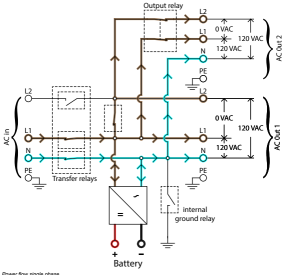I am currently using two Multiplus-II 24v/3000 2x120 inverters in parallel. From the manual, the following are the two types of internal relay connections, one for single phase and one for split phase. This is single phase.
 And this is split phase.
And this is split phase.

In the Ve Configure 3, the grid type selection is None - (feeding energy from DC to grid is not allowed). In this configuration, the inverters will provide power assist when incoming power is insufficient either on all output legs when the incoming power is single phase, and to leg one only when connected to split phase incoming power. In this configuration, the Inverter MUST provide anti-islanding LOM functionality to be legal. This point is important.
In this configuration, the automated generator control will work, but there is no warm up and cool time functionality.
To get generator Warm up and Cool down functionality, ESS must be enabled. But if ESS is enabled, the inverter apparently loses its anti-islanding, LOM functionality. The FAQ states in one part:
Q2: Can I use ESS in a vehicle or a boat?
A: No you cannot. After unplugging the shore cord it can take up to a few seconds for the system to detect the loss of mains and open the back-feed relay. During those seconds, the shore power plug will be `live`: there is 230 Volts AC on the terminals. The exact number of seconds differs per country and depends on the local requirements.
The same applies to other solution where the wiring is not protected against accidental removing, for example a simple cable with end-user removable plug, such as a portable power supply.
Q3: Can I use ESS with a generator?
A: Yes you can. Note that the only installation type where that makes sense is a land based installation (no boat, and no vehicle). A Quattro must be used with AC input 1 connected to the generator, and AC input 2 connected to the grid. The role of the generator will be to provide power during a long grid failure.
Some, bigger or better quality generators, will be able to work with LOM Type B. For other less stable generators it will be required to disable LOM entirely. In that case make the installation such that it is still safe: no simple extensions cords, use enclosed wiring cabinets with warnings on the outside and/or an external ENS.
Note that it is also possible for some generators that it is not accepted by the inverter/charger at all, unless very specific grid codes are chosen. See the section “Disabling LOM” above for details.
More information about Victron Inverter/chargers combined with Generators is in the MultiPlus Generator FAQ.
Q4: I use ESS, but have disabled feed-back, is a grid-code still required?
A: Yes, also in this case LOM is required to make for a safe and also local regulations compliant system. Running ESS with disabled-feed-back is still not the same as using a Multi in its default configuration without ESS.
----------------------
Now VE Configure ALWAYS seems to assume that the inverter being used is Quattro with two AC inputs. The Multiplus II only has a single AC Input. But this does not change the requirements for LOM.
So here is the basic question. If the LOM function is good enough and legal to use when the inverter is told not to supply DC power to the grid, Why is the LOM not good enough to allow ESS use and define zero DC feed to the grid?
Remember that in answer Q2, "No you cannot. After unplugging the shore cord it can take up to a few seconds for the system to detect the loss of mains and open the back-feed relay." Is ESS disabling proper LOM functionality, is proper LOM functionality working and using ESS changes recommendations to a more conservative value, or is LOM functionality not working properly even when ESS is not enabled and the plug connections may be energized for a few seconds even in the "the grid type selection is None - (feeding energy from DC to grid is not allowed)."
Something does not make sense. I would like a clear explanation. Maybe someone for the mother ship can explain the apparent contradiction in operation.
